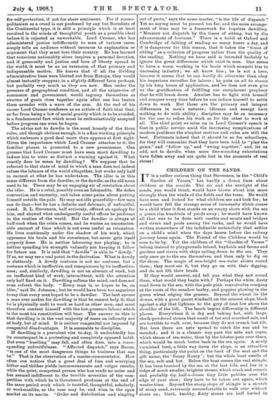CHILDREN ON THE SANDS.
IT is a rather curious thing that Stevenson, in the "Child's Garden of Verses," has hardly a dozen lines about children at the seaside. The air and the sunlight of the sands, you would think, would have blown about him more strongly than the winds of the fields and the trees. He would have seen and looked for what children see and look for; he would have felt the strange sense of immensity which comes to a child when it first stands on an empty shore with the sea a green rim hundreds of yards away ; he would have known all that was to be done with castles and moats and bridges and rivers and pools among the rocks, and he would have written somewhere of the indefinable melancholy that settles on a child's mind when the days lessen before the railway journey home again. The Friend of the Children would be sure to be by. Yet the children of the "Garden of Verses" belong instead to playgrounds inland, hayfields and farms and gardens and rivers with ships sailing down to the sea. They only once go to the sea themselves, and then only to dig on the shore. The magic of sun-bright sea-water shines round them ; they must see it, but they go on with their digging, and do not lift their heads.
If they would answer, and tell you what they saw round them, what would they begin with ? Perhaps the white, dusty road down to the sea, with the pale-pink convolvulus creeping at the roots of the meadow barley, and poppies glowing in the green wheat edging the grasses. Beyond the wheat lie the downs, with a great gaunt windmill on the nearest slope, black against a sky that lightens to the grey of heat low above the shoulder of the hill. The beach begins differently in different places. Everywhere it is dry and baking hot, with large, chalk-powdered stones that smell of tar and scorched salt, and are horrible to walk over, because they do not crunch but tilt. But here there are nets spread to catch the sun and be mended ; and it is a cleaner way past the nets and ropes, which steam of sea-water, than by the lobster-pots over there, which would be much better back in the sea again. A newly varnished boat, a little way down the slope, is an attractive thing, particularly the paint on the back of the seat and the gilt name, the 'Saucy Nancy '; but the whole boat smells of the sea, salt and hot. Below the boat conies the real shingle. It has been touched by the sea at the last tide, and lies in a ridge of much smaller, brighter stones, which crash and crunch and probably tip half-a-dozen tiny little pebbles over the edge of your shoe; they have to be taken out again, which wastes time. Beyond the sharp slope of shingle is a stretch of stony sand, extremely uncomfortable to walk over without shoes on; black, knobby, flinty stones are half buried in
a sand which is a mixture of powdered coal and chalk, and which is quite impossible to dig in, as you can prove for yourself any day when the tide is going down to the real sand rather slowly. On a beach with shingle at the top there are three other kinds of sand. One is hard and ribbed, and digs rather stiffly; another has mud just below it, and is no use for anything; the best of all is a warm, light- coloured, very smooth patch that lies rather like an island with curved banks and a river running round behind it down from somewhere out of the shingle. A wooden spade goes deeper and more easily into that kind of sand, and it extremely convenient to have the river at hand for water and the moat.
A castle can be a very simple ,buildirg, merely a mound to bid defiance to the inComing tide, or it may be designed for serious defence, which is another matter altogether. If it is to be a fortress against which the tide is to advance in vain, it should be broad and flat, with plenty of room for two or three children to stand on, a deep moat in front with a channel leading down to the sea so that the water can come up more easily, or can be led up with a spade, and a wide slope of sand built up behind down which you can retreat dryshod when the next wave will wash right over the top of the castle. That is probably the best sort of castle for children who are not allowed to take off their shoes and stockings, and have to keep their feet dry, though generally it is rather wetting waiting for the last wave of all. Another kind is more scientific, and intended to stand a siege; it has a drawbridge over the moat, and doorways in which grenadiers can be posted, and battlements with riflemen firing volleys over the top, and certainly two or three flags flying in different parts. Such a fort is best with a garden, laid out with flowers and pebble borders, and it can even stand in its own park-like, well-wooded grounds if there is enough tamarisk to be had to stick about for trees. But on the whole, especially for children who are allowed to get as wet as they like, castles are not as interesting as ponds. The proper site for a pond, or rather for a string of ponds, is the bed of one of the rivers flowing down from the shingle. If the first pond is banked up in the right way to hold a quantity of water, another can be dug a few yards below it, with a trench connecting the two, and then the water can be let out of the one into the other at a con- venient opportunity, when it simply rushes down the trench. If the pond is large enough, a boat can be sailed on it, or at all events can be in it; but as a rule natural pools are better for sailing boats than artificial pools. It is one of the ad- vantages of really good sands that you can always leave the sand and wander about the rocks, or go shrimping in the pools or the sea itself. Shrimps are the most invisible creatures possible. You may come to a pool in which there are known to be shrimps, and you will not see one, though the whole floor of the pool may be pitted with marks where they have moved and lain. Then the water is touched with a child's foot, and the brown floor is alive with darting, transparent ghosts and tiny puffs and clouds of sand. Open, sunny pools are perhaps the pleasantest to walk in ; but there is a fascination of their own in the darker, colder pools among the rocks, when you can see the bottom and know there are no large crabs hiding in the weed. Here are a pair of small fish, like baby whiting, imprisoned till the far tide comes up again, and as transparent almost as the shrimps; here is a group of sea-anemones, one with its brown-crimson tentacles stirring gently, another closed and asleep, another set round with a ring of blue jewels like turquoises ; here is the broken fluke of an anchor of a ship that was wrecked on the rocks a hundred years ago; here the chalky stones are sharp with pholas-shells, and a queer little spirt of water jumps up from a hole where some strange live creature is working, perhaps feeding. Here is the very pool where St. Brand= taught the water-babies, cool with dark- green seaweed and paved with shells, pink and white and violet ; perhaps Tom himself was hiding under the seaweed when Ellie and the Professor came over the rocks, and the Professor caught him, and he bit the Professor and dived into the sea again.
A hundred and fifty years or so ago, when Brighton was Brighthelmstone, and Dr. Richard Russell had only just dis- covered the uses of sea-bathing, nobody but very brave or very mad people went into the sea, and doubtless the sea- shore as a playground for children was hardly thought of. What other playground could possibly take its place ?
Or is it nothing more than a playground ? To a child it must be something much more ; a- world, surely, of new meanings and new possibilities. New beings inhabit it: strange creatures of uncouth shapes that belong to fairy-tales, that move with outlandish gaits, that vanish as elves and spirits vanish. A child confronted with a fair-sized crab for the first time sees a creature which perhaps looks to him rather like a large spider. He regards it with caution,- and steps from immediately in front of it in case it should •. decide to attack him. Instantly it takes on the attributes of • goblins and runs at him sideways, sidles to a pool, and die- appears in a second below the sand. The sense of a play- ground merges in the knowledge of fairyland. The real sense of a playground comes to older persons watching; wondering, perhaps, whether they are not playing with the children,- rather than the children with the sand. Children, if they think of the shore as a playground, think of it as a place always changing and always new, where they can build as • they please, find what they can, drive rivers by new courses, catch and keep tiny animals that they could never catch inland. In the gardens and fields the butterflies fly away', the rabbits will not sit still to be patted; but at the seaside it is - different ; the baby fish and shrimps and crabs are there to be caught and admired in pails. Others playing with the playing children can be not less happy, wondering over the grace and slightness of them seen alone on wide stretches of shore, and watching their hands and feet gleaming in the sunlight and the wet sand.



















































 Previous page
Previous page